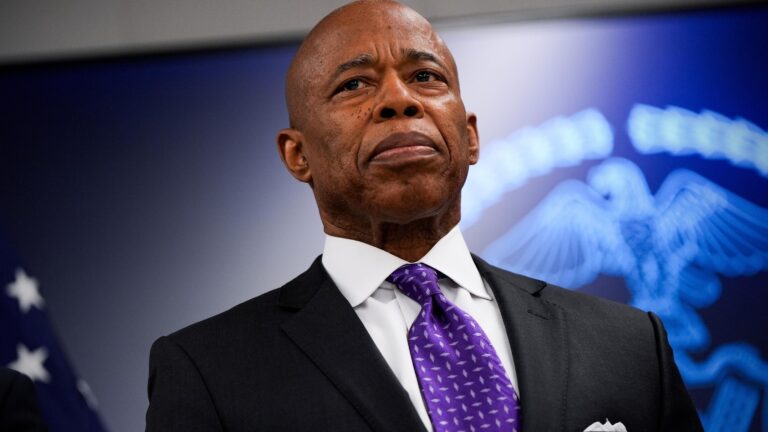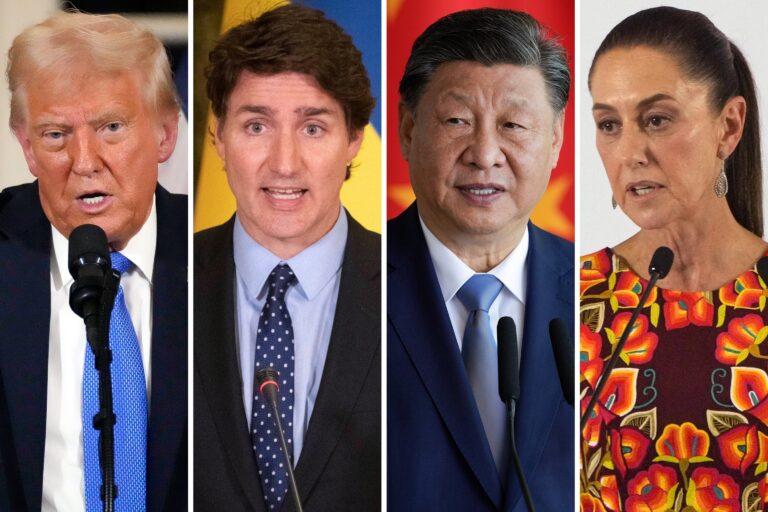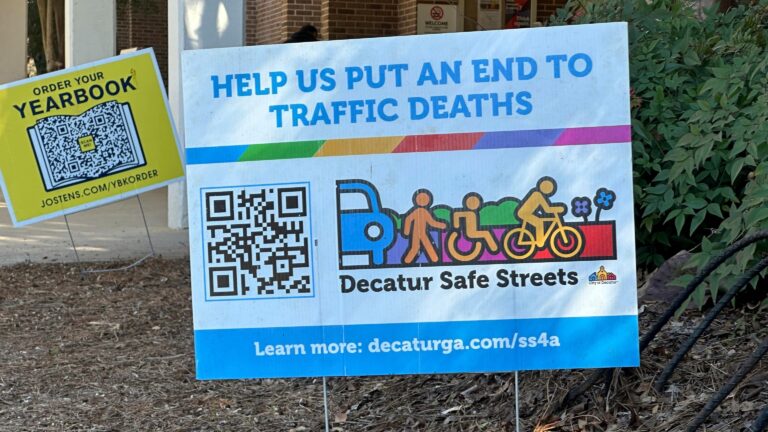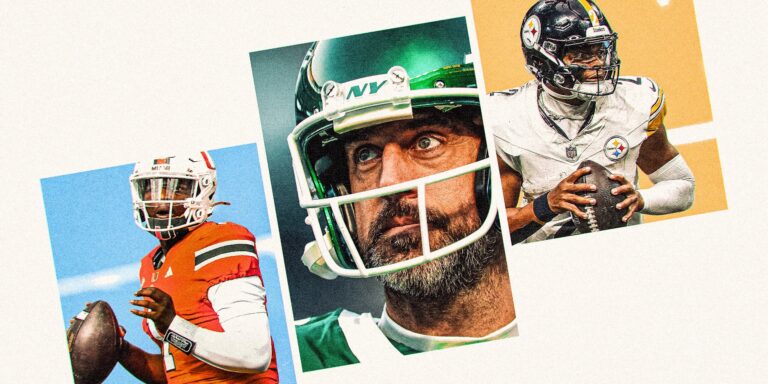The first quarterback domino didn’t end up falling.
If the Rams and Matthew Stafford had gone through with a divorce — which felt like a real possibility for a few days as the Raiders and Giants were prepared to offer significant money and draft capital to reel him in — it would’ve caused a chain reaction throughout the league. The Rams might have turned their attention to Aaron Rodgers, or Sam Darnold, or someone else. And that would have changed the options available for the other teams seeking a quarterback.
Instead, Stafford is staying in Los Angeles, leaving quarterback-needy teams looking at a mostly uninspiring quarterback market, both in free agency and in the NFL Draft.
Last year, I predicted how all the quarterback openings would be filled and … didn’t do as terribly as I remembered. Some of my hits: Bears (Caleb Williams), Buccaneers (Baker Mayfield), Falcons (Kirk Cousins), Vikings (Sam Darnold), Patriots (Jacoby Brissett), Giants (Daniel Jones) and Seahawks (Geno Smith). The misses: Broncos (Sam Howell), Steelers (Kenny Pickett and Ryan Tannehill), Raiders (Jayden Daniels) and Commanders (Drake Maye). I also sent J.J. McCarthy to the Giants, Bo Nix to the Patriots and Michael Penix Jr. to the Seahawks.
Last season, I listed nine teams as open for business — and a few more that were on the fence. There are fewer obvious openings in this cycle, and fewer exciting options on the open market too.
The legal tampering period for free agency opens next Monday at noon ET, so this felt like a good time to look ahead and predict what teams will do at quarterback.
Let’s handicap this year’s field by first figuring out how many jobs are open, which jobs might be open, and which teams are already set at starting quarterback.
Safe, but something to prove
That leaves six teams as open for business: Browns, Giants, Jets, Raiders, Steelers, Titans.
Notable options
Let’s run through the starting-caliber — or borderline starting-caliber — quarterbacks who could be available this offseason.
NFL Draft: Cam Ward, Shedeur Sanders, Jaxson Dart, Tyler Shough, Jalen Milroe
Free Agency: Aaron Rodgers, Sam Darnold, Russell Wilson, Justin Fields, Jameis Winston, Jimmy Garoppolo, Carson Wentz, Daniel Jones, Marcus Mariota
Trade/Potential cap cut: Kirk Cousins, Gardner Minshew, Kenny Pickett, Tanner McKee, Joe Milton
With the six “open for business” teams, plus four others that could get involved in the QB market, here are my predictions…
Browns: Kirk Cousins and Jalen Milroe
The rumblings out of Indianapolis were that the Browns preferred Cam Ward and perhaps aren’t high enough on Shedeur Sanders to pick him second overall. That might be a smokescreen, but Sanders isn’t widely considered that caliber of prospect anyway. Cousins has always made the most sense among the veteran options projected to be available this offseason — assuming the Falcons are not serious about making him the most expensive backup the league has ever seen — for a couple reasons.
The biggest: Kevin Stefanski was Cousins’ quarterbacks coach and offensive coordinator with the Vikings for a couple years before the Browns hired him. Cousins is coming off a career-worst year (18 touchdowns, 16 interceptions) but it was his first season post-Achilles surgery, and he dealt with other injuries too. He’s definitely on the decline but is a perfectly serviceable bridge option, whether that’s to Sanders or if Cleveland takes a swing later in the draft on someone like Milroe. The former Alabama star is more of a project as a passer but is a legitimate weapon as a runner; Stefanski can incorporate him into the gameplan as a rookie.
GO DEEPER
NFL beat writer mock draft 2025: Giants, Raiders secure their futures at QB
Giants: Aaron Rodgers and Jaxson Dart
The Rodgers-to-Giants possibility first became public once Stafford officially returned to the Rams, but there was buzz about the team’s interest in the 41-year-old all week during the combine. The Giants are exploring all veteran options, but the reality is that Rodgers is probably the best one, depending on their mileage on Darnold (who will be far more expensive than Rodgers).
From New York’s perspective, it’s a win-now desperation play for a general manager on the hot seat. Rodgers still has enough ability to serve as an inexpensive bridge option for a rookie, even if he experienced a steep decline in 2024 as he battled injuries, struggled to move around the pocket, was unwilling to take shots downfield and caused his fair share of drama. Even still, he was far better than any quarterback the Giants trotted out in 2024, and contrary to popular belief, Rodgers was viewed positively by the majority of the Jets’ locker room. Rodgers is more willing to tutor a young quarterback than many might realize, even if that plan failed with Zach Wilson. From Rodgers’ perspective, he might not have a better option than the Giants. He also recently bought a house in New Jersey and might not be eager to move unless an opportunity opened up in his home state (California). It would be a fair assumption to say that both Davante Adams and Allen Lazard would follow Rodgers to the Giants too.
The Giants could consider Sanders if he falls to No. 3, but the smarter play would be to load up with talent elsewhere on the roster. As for Dart: The Giants are flush with draft capital, with early second-, third- and fourth-round picks, plus an extra fourth. Dart seems to be the consensus third-best prospect at the moment, and some teams even have him ahead of Sanders. The Giants might be able to snag him at the top of the second round, but if not it wouldn’t be difficult for them to trade back up into the first round and get him — and then let him learn from Rodgers for a year.
Colts: Sam Darnold and Anthony Richardson
It was always going to be hard for Richardson to come back from checking himself out of a game due to fatigue. He has tantalizing tools but has not shown an ability to be a consistent, starting-caliber NFL quarterback yet, and the members of Colts leadership (particularly GM Chris Ballard) are on the hot seat. I wouldn’t even rule out a team calling the Colts about trading for Richardson, though his value is pretty low for someone drafted fifth overall two years ago.
Ballard, somehow, is getting another shot at finding a quality starting quarterback. Darnold is the top free agent available coming off a stellar 2024: 4,319 yards, 35 touchdowns and 12 interceptions. PFF projects Darnold to get a contract worth more than $40 million a year, so the Colts would be banking on him playing like he did before poor performances in regular-season-finale and wild-card-playoff losses.
GO DEEPER
2025 NFL free-agency rankings top 150: Where do Aaron Rodgers, Tee Higgins, Sam Darnold fall?
Jets: Justin Fields and Tyrod Taylor
Taylor is on the Jets’ roster at a reasonable rate ($6.8 million cap hit) and it would not be shocking at all if he wound up being Aaron Glenn’s Week 1 starter. But there has been a lot of buzz about the prospect of the Jets going after Fields and it makes some sense — he’s young (25), mobile and might have some untapped potential, even if he’s been inconsistent as a thrower in the NFL. He was off to a nice start in Pittsburgh last year before they ultimately opted to bench him for Russell WIlson.
The most likely outcome for Fields this summer is that a team like the Jets gives him a one- or two-year prove-it type deal loaded with incentives, which would give him a shot at a bigger payday (a la Darnold) in a year or two. Fields has a history with Jets wide receiver Garrett Wilson (they played together at Ohio State) and New York will have the cap space to sign him if they’re bidding against other teams — which sounds like a real possibility. PFF projects a one-year, $11 million deal but I think it will wind up taking more than that.
Signing Fields won’t preclude the Jets from taking a shot on a Day 2 or Day 3 quarterback prospect. My early prediction: Ohio State’s Will Howard or Syracuse’s Kyle McCord.
Raiders: Russell Wilson and Quinn Ewers
The Raiders were viewed as having a real shot at Stafford, largely because of the presence of Tom Brady. Most signs point toward the Raiders prioritizing proven veterans over unproven rookies, or even question marks like Fields or Darnold. Wilson is probably the next-best veteran on the market after Rodgers, and there are a lot of fun storylines that would come with him going to Las Vegas: He’d reunite with coach Pete Carroll and join forces with Brady, who Wilson lost to in Super Bowl XLIX.
The Raiders also have an early second-round pick (No. 37), and two early thirds (No. 68 and No. 73) and would be smart to add a developmental talent, like Ewers, after the first round.
Saints: Derek Carr and Shedeur Sanders
The Saints don’t really have much of an avenue to improve this position and might be stuck with Carr for now. New Orleans is already $47 million over the cap and wouldn’t get much relief by cutting Carr pre-June 1 ($1.3 million), and he’s unlikely to garner any trade interest at this point. So the Saints are more likely to just roll with him for one more year.
That wouldn’t preclude them from drafting someone. I think it’s conceivable at this point that Sanders drops out of the Top 5; he would offer the Saints a way out of the quarterback purgatory they’ve found themselves in since Drew Brees retired. If Sanders falls to No. 9 and the Saints are high enough on him, it’s worth taking the swing.
Seahawks: Geno Smith
The Seahawks will stay the course with Smith for at least one more season. He’s proven to be a perfectly capable, if inconsistent, quarterback at this stage of his career. Over the last three seasons he’s averaged 4,242 passing yards and threw 71 touchdowns and 35 interceptions — with 15 picks coming in 2024, the most since his rookie year with the Jets. He might have some value if the Seahawks opt to go in another direction, especially since they’d save $31 million in cap space by trading him, but I don’t see that happening.
Steelers: Daniel Jones and Tyler Shough
I’ll be honest, I had the hardest time predicting what Pittsburgh does. There is a lot of noise about the Steelers preferring to keep either Fields or Wilson, but that was also the noise about Mason Rudolph and Kenny Pickett last year and that didn’t exactly come to fruition. I think Fields will ultimately choose between the Jets and Steelers — and keep in mind that Pittsburgh benched him last season even though he was playing relatively well. If Pittsburgh brings him back while committing to him as a starter, though, that could give them the edge.
I ultimately decided to go with the Jets for Fields, but it’s a close call. As for who Pittsburgh winds up targeting if not Fields? I considered Cousins and Rodgers here, but Cleveland and New York just make more sense for both at the moment. I don’t think the Steelers will pick a quarterback in the first round. Jones would be an interesting low-cost flier, as he could be a good fit in Arthur Smith’s run-heavy offense, and Pittsburgh would be the best environment he’s been in as a starter in terms of culture, coaching and talent around him. Pairing Jones with a developmental Day 2 or Day 3 prospect would be a way of taking two shots at finding a starter — and Shough has some intriguing potential because of his size (6-5) and athleticism, though he has an injury history and will be 26 in the fall.
If the Saints do wind up moving on from Carr, he becomes a real possibility here too. I could also see Pittsburgh bringing in a third veteran quarterback to be part of the conversation — someone of the Carson Wentz, Jimmy Garoppolo, Jameis Winston, Gardner Minshew ilk.
Titans: Cam Ward
There’s been a lot of assumption that the Titans will trade out of the No. 1 pick to accumulate more assets. Has anyone ever stopped to ask why they wouldn’t just take the top quarterback prospect themselves? Will Levis is clearly not the answer. There are no other obvious solutions for a team that’s not quite a contender yet. And Ward at least has the potential to be something special, even if he’s not a surefire prospect like past No. 1 picks. The Titans have some pieces already in place to help him, including talented running backs (Tony Pollard, Tyjae Spears), a wide receiver (Calvin Ridley) and a couple first-round offensive linemen (JC Latham, Peter Skoronski). Maybe the Titans don’t view Ward as a potential franchise quarterback — or perhaps they value the potential of someone like Abdul Carter or Travis Hunter more. It’s certainly possible the Titans wind up trading out of this pick, but that’s far from a lock.
Vikings: J.J. McCarthy and Carson Wentz
For a while, the prospect of bringing Darnold back for another year while McCarthy works his way back from a torn meniscus seemed like a legitimate possibility. But as time as passed, and Darnold struggled in two big games, that began to feel less likely. Minnesota is very high on McCarthy’s potential, which he flashed in training camp and the preseason last year.
If Jones doesn’t get a starting shot elsewhere I think he’ll return to the Vikings as a potential stopgap until McCarthy is ready. But if not him, I still anticipate the Vikings adding a playable veteran at the position — I considered both Wentz and Jimmy Garoppolo here. I went with Wentz because, to me, he fits the Darnold mold of a former highly drafted quarterback seeking redemption. Wentz was an MVP frontrunner in 2017 before tearing his ACL. He had moments in both Indianapolis and Washington, but stints with both teams ended poorly. He’s been humbled as a backup the past two seasons, learning behind Matthew Stafford and Patrick Mahomes and from both Sean McVay and Andy Reid. If there’s a coach who can get something out of Wentz, it’s Kevin O’Connell.
(Illustration: Dan Goldfarb / The Athletic; Photos: Rich von Biberstein / Icon Sportswire, Luke Hales, Kevin C. Cox / Getty Images)






